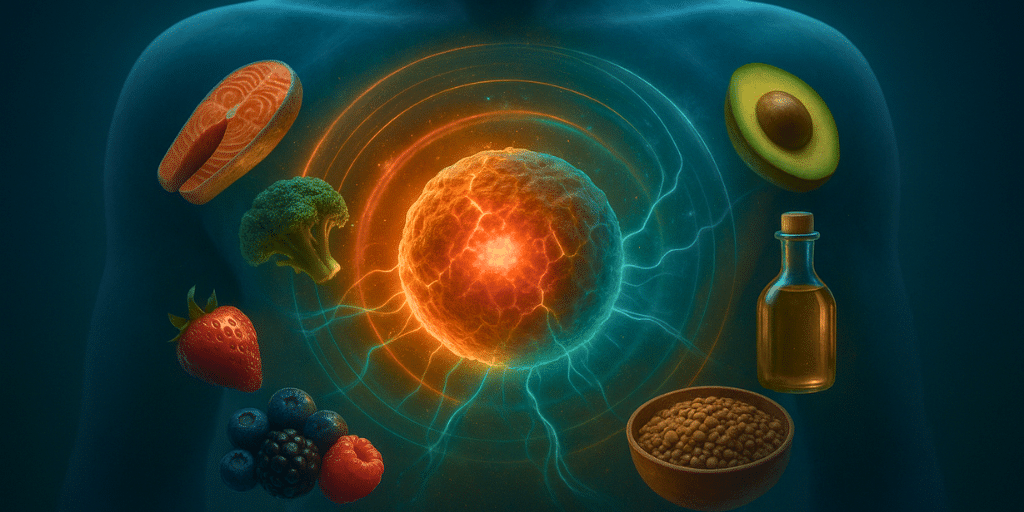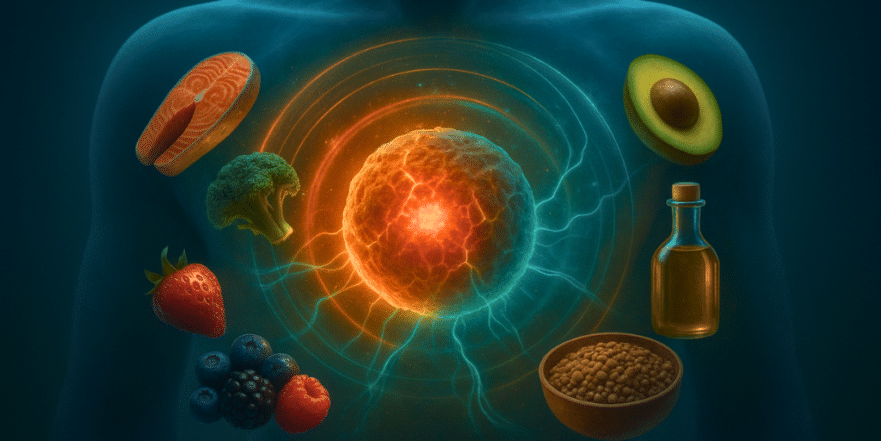
If you’ve been diagnosed with cancer, one of the first questions you probably asked your doctor was, “What should I eat?” And if you were told, “It doesn’t matter, eat whatever you want,” you’re not alone. To me, that is some of the most dangerous advice a person can receive. The reality is that what you eat can either feed cancer or help starve it. Your diet is one of the most powerful tools you have at your disposal.
This isn’t about selling you a specific diet or product. This is about giving you information and a strategic framework to think about nutrition in a completely new way. The information here is based on extensive research into the metabolic nature of cancer cells. However, it is absolutely crucial that you discuss any dietary changes with your doctor or oncologist. What I’m sharing is a strategy that can be used alongside conventional treatments like chemotherapy or radiation, not as a replacement. The goal is to empower you with knowledge so you can make the best, most informed decisions for your health.
Key Takeaways
- Cancer cells are metabolically inflexible: Unlike healthy cells, many cancer cells rely heavily on specific fuels to grow and multiply. The most common fuels are glucose (sugar) and glutamine (an amino acid).
- Cancer can adapt: If you starve a cancer cell of one type of fuel for too long, it can adapt and learn to use another. This is why a single, static diet may not be the most effective long-term strategy.
- Diet rotation is a powerful strategy: By strategically rotating your diet, you can continuously cut off the fuel supply to cancer cells, preventing them from adapting and thriving.
- Fasting is your secret weapon: Intermittent and prolonged fasting are incredibly effective at depriving cancer cells of the resources they need while promoting cellular repair (autophagy) in your healthy cells.
- This is a multi-pronged approach: Diet is just one piece of the puzzle. Optimizing vitamin D levels, exercising, and managing stress are also critical components of a comprehensive plan.
1. Understanding Your Enemy: What Cancer Cells Really Eat
Before you can fight an enemy, you have to understand it. One of the most important things to know about cancer is that it’s not just one disease; it’s incredibly diverse, or “heterogeneous.” Different cancers, and even different cells within the same tumor, can have different weaknesses and, importantly, different appetites. Cancer cells are essentially damaged versions of your normal cells. This damage often occurs in the mitochondria, the energy factories of the cell. When this happens, the cell reverts to a more primitive and inefficient way of generating energy, which makes it vulnerable.
These metabolically “sick” cells need specific fuels to survive. The vast majority of fast-growing cancers, like many breast, colorectal, lung, and brain cancers, are addicted to glucose. They gobble up sugar at a rate far higher than healthy cells. Another primary fuel is an amino acid called glutamine. Some tumors may contain a mix of cells, with some preferring glucose and others preferring glutamine. Other cancers, especially those influenced by hormones like certain prostate and breast cancers, can learn to use lipids (fats) as fuel. A smaller subset can even use branched-chain amino acids (BCAAs). Understanding which fuel your specific cancer prefers is the first step in designing a strategy to starve it.
2. The Problem with a “One-Size-Fits-All” Diet
Given that most cancers love sugar, the logical first step is to cut out sugar and adopt a ketogenic diet, which is very low in carbohydrates. This is an excellent starting point. However, cancer is a survivor. Just like bacteria can become resistant to antibiotics, cancer cells can become resistant to a single dietary strategy. If you consistently deprive a tumor of glucose, some of the cancer cells may die off, but a few resilient ones might adapt. They can switch their metabolism to start using glutamine, or fats, or another available fuel source.
This is why you might see initial success with one diet, only to have it become less effective over time. The cancer cells that survive the initial dietary change can become supercharged and even more resilient. This adaptive nature is the core reason why a static, long-term diet might not be enough. You have to be smarter than the cancer, and that means you can’t let it get comfortable. You need a dynamic approach that keeps the cancer cells off-balance and constantly guessing where their next meal is coming from.
3. The Core Strategy: Diet Rotation and Fasting
This brings us to the central strategy: diet rotation combined with fasting. Instead of picking one diet and sticking to it forever, you cycle through different dietary approaches, each one designed to target a different cancer fuel source. Imagine you have a tumor with cells that eat glucose and cells that eat glutamine. You start with an anti-glucose diet (keto) for 10-14 days. This starves the glucose-dependent cells. But before the glutamine-dependent cells can take over and thrive, you switch to an anti-glutamine diet for 4-5 days. This hits the other population of cells. By rotating back and forth, you never give either type of cell a chance to establish dominance and grow.
Fasting is the amplifier for this strategy. When you practice intermittent fasting—for example, eating only one or two meals a day—you create a daily window where fuel is scarce for cancer cells. But even more powerful is prolonged fasting. Regularly incorporating 24, 48, or even 72-hour fasts can trigger a deep cellular cleansing process called autophagy, where your body recycles old, damaged cells—including cancer cells. This puts immense metabolic stress on cancer while rejuvenating your healthy cells. Combining diet rotation with a regular, yet erratic, fasting schedule creates a profoundly hostile environment for cancer.
4. How to Rotate Your Diets: Practical Examples
The specific rotation you use depends on the type of cancer you have. It’s best to work with your doctor and use genetic information about your tumor if available. Here are a few examples of what this might look like:
- For Glucose/Glutamine-Dependent Cancers (e.g., Glioblastoma, Colorectal, most Lung Cancers): You would start with a strict anti-glucose (ketogenic) diet for about 10 to 14 days. Then, you would switch to an anti-glutamine diet, which is primarily plant-based and avoids high-glutamine foods, for 4 to 5 days. After that, you rotate back to the ketogenic diet and repeat the cycle.
- For Lipid-Dependent Cancers (e.g., some Prostate Cancers): The rotation might look different. You could start with a very short anti-glucose phase of 2 to 3 days, and then switch to an anti-lipid (low-fat) diet for a longer period. This low-fat diet wouldn’t be zero-fat; it would emphasize anti-inflammatory omega-3 fatty acids, which don’t appear to fuel these cancers, while strictly limiting other fats.
- For BCAA-Dependent Cancers (e.g., some Liver Cancers): Here, you might do an anti-glucose diet for 5 to 7 days, followed by an anti-BCAA diet for 7 to 10 days. The anti-BCAA diet is challenging because these amino acids are in many foods, but it generally involves focusing on specific plant-based foods that are naturally low in them.
The key principle is to identify the likely fuels and cycle through diets that restrict them. The foods included in these plans are not just about restriction; they are also chosen for their inherent anti-cancer properties, such as cruciferous vegetables, berries, and healthy fats.
5. What About Ketones? A Word on Advanced Cancers
There is a controversial but important point to discuss: some very advanced, late-stage cancers can learn to use ketones as a fuel source. This is a survival mechanism of last resort for the most aggressive cancers. This is why it’s so helpful to know as much as you can about your specific cancer. If you are dealing with a late-stage, aggressive cancer, a standard ketogenic diet might not be the best starting point. In this scenario, the strategy may involve rotating between anti-glutamine and anti-ketone diets, which are largely plant-based and low in protein. You might need to incorporate very short periods (1-3 days) of higher protein intake to maintain muscle mass before returning to the restrictive cycles.
This is also where prolonged fasting becomes absolutely essential. You might ask, “If I’m fasting, my body is producing ketones. Won’t that feed the cancer?” Interestingly, the research suggests that the ketones produced during a therapeutic fast do not seem to fuel these cancers in the same way. Prolonged fasting of several days or even weeks (under strict medical supervision) has been shown in some cases to be incredibly effective at wiping out even the most advanced cancers.
6. Beyond Diet: Other Powerful Tools in Your Arsenal
While diet rotation and fasting are the cornerstones of this metabolic strategy, they are most effective when combined with other healthy practices. Think of these as additional ways to weaken cancer and strengthen your body.
- Optimize Vitamin D: Cancer cells are known to block your body’s vitamin D receptors to protect themselves. To overcome this, you need to get your vitamin D levels much higher than the standard range, ideally around 90-100 ng/mL. This can be achieved through sensible sun exposure and supplementation. Vitamin D is critical for a strong immune response.
- Exercise: Physical activity does more than just make you feel good. It floods your body with oxygen. Cancer thrives in low-oxygen environments, so increasing oxygenation through exercise puts direct stress on cancer cells.
- Strategic Prolonged Fasting: Don’t get into a predictable routine. Cancer can adapt to patterns. One week, do a 48-hour fast. Two weeks later, do a 72-hour fast. A week after that, maybe you only do a 24-hour fast. This erratic schedule is a powerful strategic tool that keeps the cancer from adapting to your fasting regimen.
Conclusion
Receiving a cancer diagnosis can feel overwhelming and disempowering. But your diet is something you can control. Viewing food not just as sustenance but as a strategic tool can transform your mindset and your health. The principle of diet rotation is designed to outsmart cancer’s adaptive capabilities by systematically and repeatedly cutting off its fuel. When combined with the powerful cellular reset of fasting and other healthy lifestyle choices, it creates a comprehensive approach to support your body’s fight.
Remember, this is not about abandoning conventional medicine. It’s about adding every possible tool to your toolbox. Do your own research, talk to your doctor, and take an active role in your healing journey. You have more power than you think.
Source: Dr. Eric Berg

